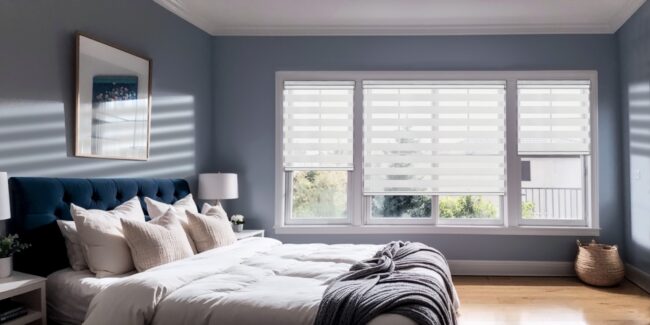
Window coverings play an important part in the decoration of your home. The window coverings not only make the room beautiful but also provide privacy, regulate temperature and control light. There are many different options for blinds, shades and shutters. This can make it difficult to pick the best one.
In this guide we will look at different types and explain them in simple terms. We will also examine their pros and cons, and help you determine which one is the best for your house.
Why Window Coverings Matter
Window coverings do more than just block sunlight. They help with:
Privacy: Keep your home safe from outside eyes.
Light Control: Let in just the right amount of sunlight.
Style: Add beauty and personality to your rooms.
Temperature: Keep rooms cooler in summer and warmer in winter.
Noise: Some coverings help reduce outside sounds.
1. Blinds: The Light Controller
Blinds are the classic window coverings with a cord or wand that lets you tilt the slats open or closed.
How Blinds Look & Operate:
Blinds come with separate slats in materials such as vinyl, aluminum and wood. You can tilt or raise the blinds with a twist of a wand or by pulling on a cord. You can choose how much privacy and/or light you would like, from fully closed to completely open.
Popular Types of Blinds:
Horizontal Blinds
You will find these in many houses. You can pull the cord easily to lift the blinds or twist the wand to adjust the slats.
Vertical Blinds
These come with vertical slats, a great option for covering large glass sliding doors or windows. To adjust the brightness, the slats of the blind can be pushed to one side or tilted.
Motorized Blinds
These blinds open and close with the push of a button on a remote or your phone. They’re super convenient, especially for hard-to-reach windows.

Zebra Blinds
Zebra window blinds have a modern look with alternating sheer and solid stripes on the fabric. You simply adjust them to create the perfect mix of light and privacy.
Pros of Blinds
- Great Light Control: Tilt slats in order to reduce glare, without having to close the blinds.
- Good privacy: They are closed and block the outside view.
- Easy to clean: Just wipe with a wet cloth to keep it clean.
- Budget-Friendly: They are a great window covering choice.
Cons of Blinds
- Look simple: They do not always have that “wow” factor associated with shades or shutters.
- Dust problem: All those individual slats collect dust and require more frequent cleaning.
- Cords can be a hazard: Dangling cords pose a risk to children and pets. Choose modern cordless devices for safety.
Best For: Home offices, kitchens, bathrooms, and rooms where you need precise light control on a budget.
2. Shades: The Style & Softness Expert
Shades are a softer window covering made from one piece of fabric. They give your room a clean and cozy feel.
How Shades Look and Work:
They can be folded or rolled (like an accordion), and positioned neatly on top of the windows. No slats. They are fabric and come in a variety of colors, textures, patterns, etc. to match any decor.
Popular Types of Shades:
Roller Shades
A simple, modern sheet of fabric that rolls up and down.
Roman Shades
These fold up into elegant, horizontal pleats when raised.
Cellular/Honeycomb Shades
Cellular window shades have a unique honeycomb design that traps air, providing excellent insulation to keep your home warmer in winter and cooler in summer.
Pros of Shades
- Offer a clean and soft look.
- Provide excellent light control and privacy.
- Help in saving energy by insulating windows.
- Wide variety of fabrics and patterns to match any décor.
Cons of Shades
- Can’t be adjusted like slats, only up or down.
- Fabric can get dirty more easily and may need gentle cleaning.
- Custom options can be more expensive.
Best For: Bedrooms (with blackout fabric), living rooms, dining rooms, and anywhere you want to add a soft, decorative touch and improve insulation.
3. Shutters: The Permanent Classic
Shutters are a classic and sturdy window covering. They are permanently attached to your window frame, becoming a part of the window itself.
The Look and Function of Shutters:
Shutters have horizontal rails with vertical stiles to hold louvers. They are made out of wood, synthetic materials or both and are installed inside the window frame. As they are very sturdy, they can be considered an improvement to your home that will increase its value.
Popular Types of Shutters:
Plantation Shutters
These shutters contain wide louvers (often 3.5 inches or larger) which are distinctive, stylish as well as fresh appearance and great light control.
Café Style Shutters
Just the bottom half of each window is covered by these, safeguarding your privacy while allowing plenty of light to enter from overhead.
Pros of Shutters
- Very durable and long-lasting.
- Add value to your home.
- Excellent control of light and privacy.
- Easy to clean — just wipe them down.
- Provide great insulation and noise reduction.
Cons of Shutters
- More expensive than blinds or shades.
- Installation is permanent and may need professional help.
- Heavier look, not suitable for all window sizes.
Best For: Living rooms, master bedrooms, sunrooms, and for homeowners looking for a permanent, high-value upgrade.
Final Thoughts
Window coverings do more than just decorate your home, they control light, add privacy, and improve energy efficiency.
- Blinds are flexible and affordable.
- Shades bring warmth and elegance.
- Shutters offer timeless beauty and lasting value.
Think about your home’s style, how much light you want, and your budget. No matter which one you choose, the right window covering can completely change the look and feel of your space, turning a plain room into a comfortable, stylish, and inviting place to live.
